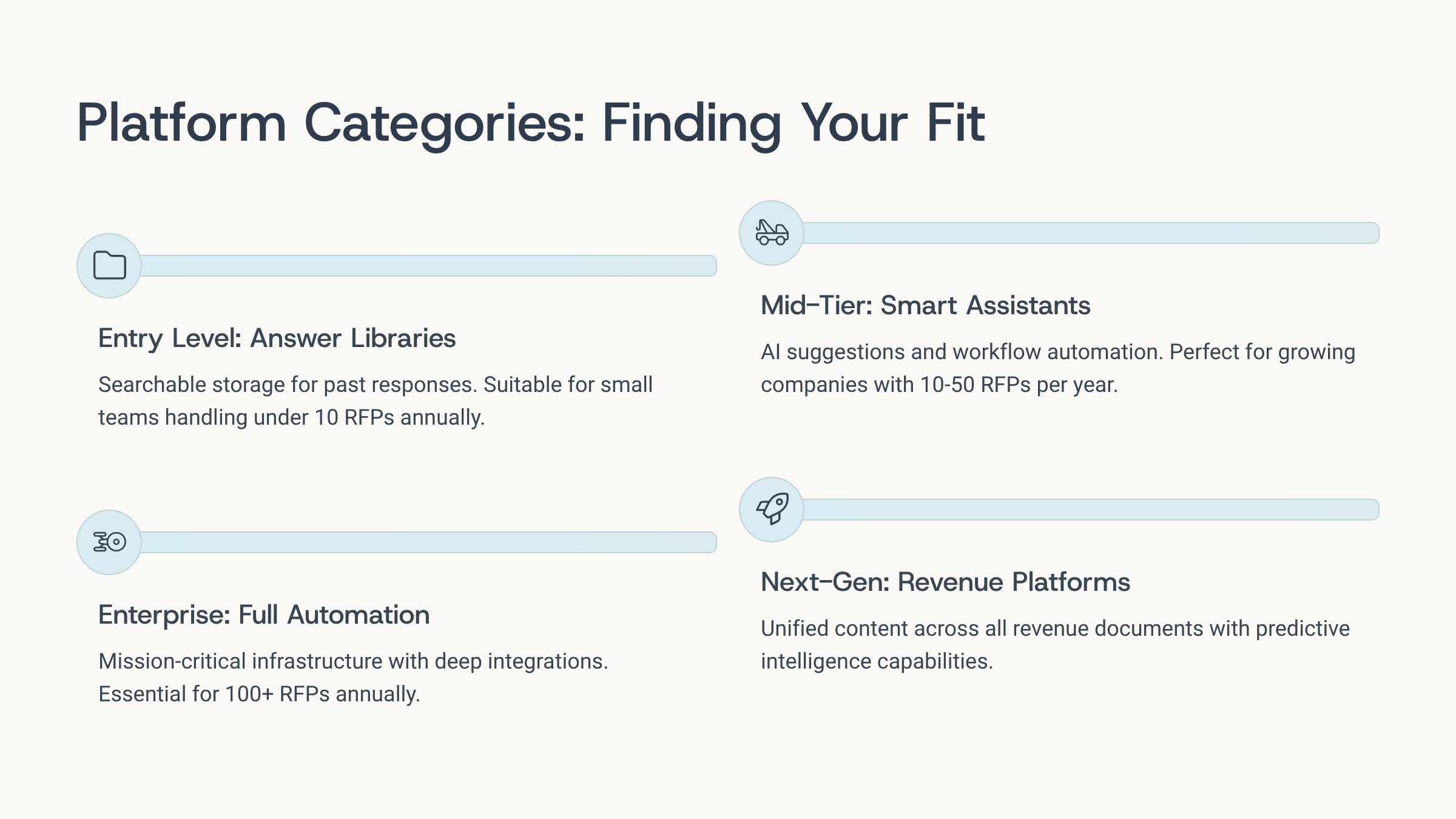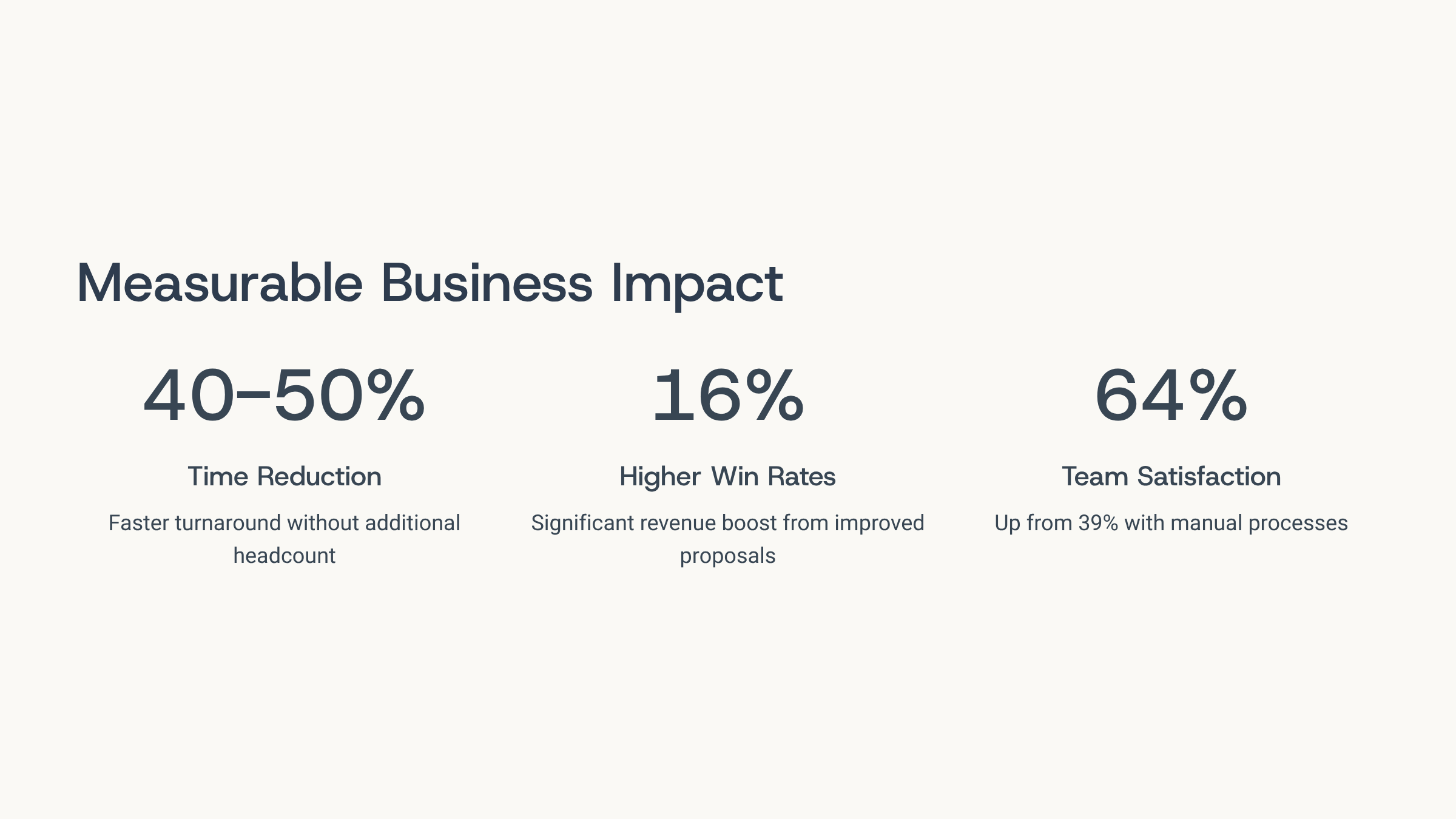RFP Automation Platforms: Features, Benefits, and Real ROI
Article written by
Kate Williams

INSIDE THE ARTICLE
SHARE THIS ARTICLE
Summary
If RFPs are draining your sales team, it’s time for a better way. This blog breaks down how an RFP automation platform turns a painful, manual process into a fast, trackable, revenue-producing machine. From smarter workflows to real-time analytics and AI-assisted answers, learn how the right tool can help you win more, faster—with less stress.
Have you noticed? On paper, most enterprise RFP processes look immaculate. But once you peel back the surface, it’s a mess. Around 84% of enterprises still use old-school RFP workflows, and employees spend close to 20% of their time just chasing down info. That’s one full day out of the week gone to hunting rather than selling or strategizing.
It's simple. Manual RFP processes don’t scale anymore. Enterprises that still cling to Excel and email chains are leaving money, time, and credibility on the table every single day. That's why most of the organizations have already switched to RFP automation tools that help them build customer trust, crack more deals, and definitely increase revenue. Let's dive into details about the whats, hows, and whys of this switch.
What RFP Automation Platforms Actually Do
So, what’s the alternative? RFP automation platforms. These aren’t just fancy databases. They’re built to fix the exact pain points enterprises struggle with.
They:
- Centralize knowledge so everyone stops asking, “Where’s the latest version of that response?”
- Use AI to draft answers in minutes, not hours, by pulling from past RFPs.
- Automate compliance checks so you’re not sweating about SOC 2 or GDPR.
- Enable collaboration without 20 overlapping email threads.
- Plug into CRMs, CPQs, and ERPs so the RFP process isn’t living in its own lonely silo.
- And they throw in analytics so you can finally see which answers win and which ones flop.
But let’s be honest: the best platforms today go way beyond the basics. Here’s what they really do when done right:
Content Intelligence
- Knows Your Business: Every policy, feature, and differentiator is captured.
- Learns From Wins: It notices which answers actually help close deals.
- Updates Automatically: If something changes—pricing, policy, or compliance—the platform updates every relevant answer.
- Suggests Improvements: It doesn’t just store responses; it nudges you to sharpen them based on win/loss data.
Workflow Automation
- Smart Assignment: The right question lands with the right person, automatically.
- Parallel Processing: Multiple SMEs can work on the same RFP simultaneously without stepping on each other.
- Deadline Management: Forget endless calendar reminders; the system tracks it for you.
- Approval Workflows: Legal, security, and finance—all coordinated, no chasing signatures.
AI That Actually Helps
- Answer Matching: “You’ve answered this 47 times. Here’s the best version.”
- Confidence Scoring: Flags which answers are rock solid and which need a human touch.
- Competitive Intelligence: Spots patterns in what prospects are asking and what your competitors likely seeded.
- Personalization: Adjusts tone and detail to fit the prospect—short and snappy for a startup, compliance-heavy for a bank.
Analytics That Drive Revenue
- Win/Loss Correlation: Shows which answers predict success.
- Bottleneck Identification: Tells you where processes break down.
- ROI Tracking: Measures the actual revenue impact of proposals.
- Team Performance: Surfaces who’s contributing, who’s lagging, and where training might help.
In other words, modern RFP platforms don’t just help you answer faster. They help you answer smarter—and more importantly, win more often.
The Platform Categories That Matter
Not every RFP tool belongs in the same bucket. The market has split into clear categories, and understanding these tiers is critical if you don’t want to waste money or hit a wall in two years.
Entry Level: Answer Libraries
These are basically searchable storage lockers for your past responses. You upload old RFP answers, tag them, and hope someone remembers the right keyword when searching. It’s still mostly manual work—copy, paste, edit.
Scenario: A small consulting firm handling five RFPs a year might survive here. The proposal manager (who is also the office’s unofficial IT guy) just needs somewhere better than Dropbox to find old answers. Better than nothing, but not built for scale.
Mid-Tier: Smart Assistants
This level introduces AI-powered suggestions and light workflow automation. The system recognizes questions you’ve answered before and suggests a draft. You get some collaboration features too—no more emailing 12 different versions of the same spreadsheet.
Scenario: A growing SaaS company moving from 10 to 50 RFPs annually fits here. They’re still scrappy, but their sales team is begging for help. The “smart assistant” tier cuts response time and keeps the wheels turning.
Enterprise: Full Automation
This is where you move from “helpful” to mission-critical. End-to-end automation handles everything from smart assignments to compliance workflows. Deep integrations with CRM, ERP, and CPQ mean data flows across systems. Advanced analytics show where you’re losing time, what answers are winning, and even predict your chances on a deal.
Scenario: A global bank responding to hundreds of security questionnaires and RFPs every year absolutely needs this. Without automation, their legal and security teams would collapse under the volume. Here, the platform isn’t just a tool—it’s infrastructure.
Next-Gen: Revenue Platforms
This is the newest category. These platforms don’t stop at RFPs; they cover the whole revenue document universe: proposals, due diligence forms, sales decks, and vendor security checklists. They unify content across all customer-facing documents and add predictive intelligence. Instead of just helping you respond faster, they’re helping you win smarter.
Scenario: Think of a modern enterprise sales team—200+ reps, a presales crew, legal, compliance, and RevOps all juggling different content needs. A platform like SparrowGenie fits here, powering not just RFPs but the entire revenue engine. This isn’t just automation—it’s about building a content backbone for every deal.
For enterprises, this category breakdown matters because picking the wrong level means either overpaying for features you’ll never use—or worse, being stuck with tools that don’t scale when you suddenly double your deal flow.

5 Key Features of Enterprise RFP Automation Platforms
The features aren’t bells and whistles—they’re survival kits for enterprise teams. Here are a few features that can change the game for your team:
1. AI-Powered Content Libraries
No more copy-paste-edit till midnight. AI pulls the right response from your content library and adjusts it for context. Some teams cut their repetitive work by 65% this way.
2. Automated Compliance
Enterprises in finance, healthcare, or defense can’t afford even a single misstep. These platforms flag risky clauses and build compliance matrices that improve win rates by almost 10%.
3. Collaboration That Actually Works
Instead of “final-final-v3.docx,” you get one single version in the platform. Everyone edits, reviews, and approves—done.
4. Integrations Everywhere
From Salesforce to SAP, modern RFP software connects with the stack you already use. No more retyping data from one system to another.
5. Analytics and Insights
It’s not just about answering questions. The platform tracks content usage, proposal velocity, and win/loss patterns. You know what’s working, what’s not, and where to improve.
For a small team, these features are convenient. For an enterprise? They’re the only way to keep the ship afloat.
.png)
Benefits of RFP Automation for Enterprises
The obvious benefit is speed. Most companies see a 40–50% reduction in turnaround time, which means they can handle way more RFPs without hiring new people.
But that’s not the whole picture. Teams using automation also win more—up to 16% higher close rates. Considering that RFP-driven business often makes up 30–40% of enterprise revenue, that’s a serious bump to the bottom line.
Then there’s the human side. Satisfaction with the RFP process has jumped from 39% to 64% in companies that automated. Why? Because people stop wasting their time on busywork. Cross-departmental collaboration improves too—sales, legal, and procurement finally stop working in silos.
So the benefits aren’t just about shaving hours. They’re about increasing revenue, reducing burnout, and making the whole organization sharper.

Calculating Real ROI of RFP Automation
CFOs want math, not fluff. Thankfully, the ROI here is straightforward.
ROI = (Cost Savings + Revenue Increase – Total Investment) ÷ Total Investment × 100
Here’s how it plays out in real life:
- Hours saved: 3,000 × $50/hr = $150,000.
- Extra revenue from more wins: $32,000.
- Cost of platform + training: $50,000.
- ROI = 254% in the first year.
For many enterprises, the payback comes in under 12 months. That’s why RFP automation platforms aren’t seen as “nice-to-have” anymore—they’re budget-approved, board-approved necessities.
Real-World Case Study That Proves the Value
The numbers hit harder when you see them in action. Here is a simple yet impactful case study that can help you imagine the power of RFP automation:
Microsoft: 7,000 employees tapping into a central library of 36,200 responses. Outcome? $2.4M saved in 18 months.
This isn't an isolated win—it's proof that the enterprise standard is shifting. Teams without automation are going to struggle to keep up.
Enterprise Considerations When Selecting a Platform
Not every RFP tool is built for enterprise. Here’s what you need to keep in mind:
- Scalability: If it can’t handle 250+ RFPs a year, it won’t last long.
- Security & Compliance: SOC 2, ISO 27001, GDPR—you need them all.
- Integrations: CRM, ERP, CPQ, productivity suites. No integration = no adoption.
- SLAs: Don’t just trust uptime promises. Check recovery times (RTO/RPO) too.
- Total Cost of Ownership: Factor in licenses, upgrades, and implementation help.
Pick wrong, and you’re back to fire drills and copy-paste chaos. Pick right, and you’ve got a foundation that scales with your growth.
The Future of RFP Automation Platforms
Here’s where things get interesting. In the next couple of years:
- 90% of repetitive drafting will be automated.
- Teams will turn around proposals 40% faster thanks to AI.
- Platforms will crunch competitor data to suggest price-to-win strategies.
- Proposal managers won’t just draft—they’ll advise, strategize, and guide deals.
AI won’t replace humans here. It’ll handle the boring 80%, so humans can focus on the 20% that actually wins the deal. That’s the shift enterprises need to prepare for.
Conclusion: Why Enterprises Must Modernize Now
If you’re still managing RFPs with spreadsheets and email chains, you’re already behind. The errors, the delays, the missed opportunities—they’re costing you millions. Hence, there is no longer a “should we” conversation. It’s “how soon can we.” Enterprises that adopt RFP automation now will set the pace. The ones that don’t will be left explaining to the board why they keep losing deals. Hence, switch to RFP automation platforms like SparrowGenie that could be your survival tool in the enterprise world.
Ready to see how AI can transform your RFP process?
Product Marketing Manager at SurveySparrow
A writer by heart, and a marketer by trade with a passion to excel! I strive by the motto "Something New, Everyday"
Frequently Asked Questions (FAQs)
Related Articles

AI for RFP Responses: How to Turn Your 10-Day Marathon Into a 2-Day Sprint

Team Collaboration on RFPs: Essential Steps to Build Winning Proposals
